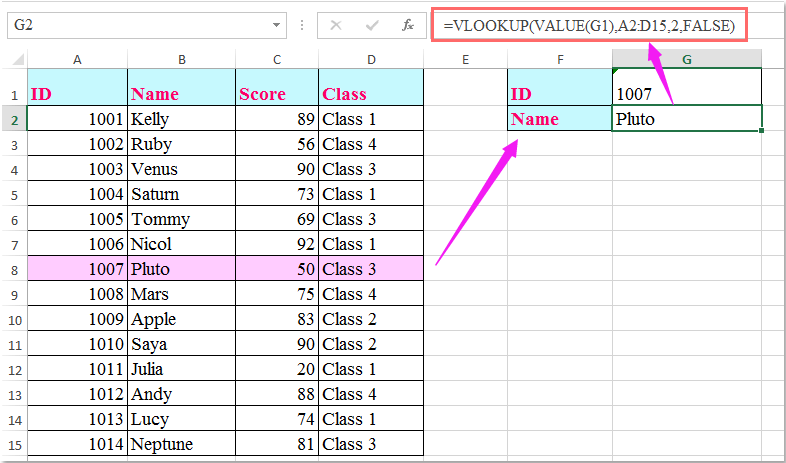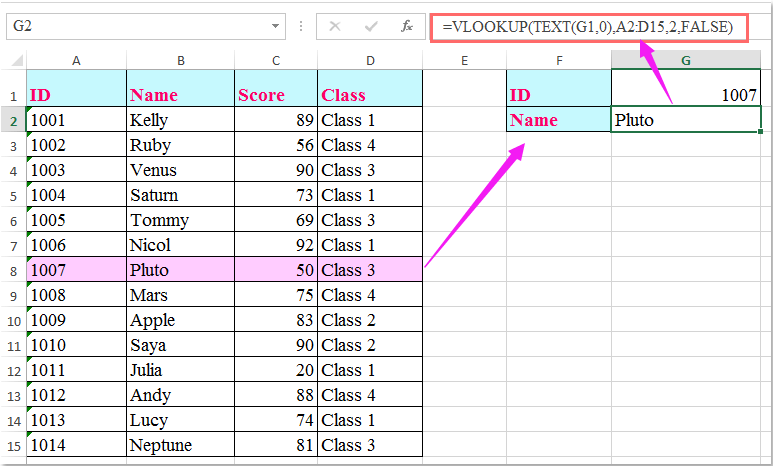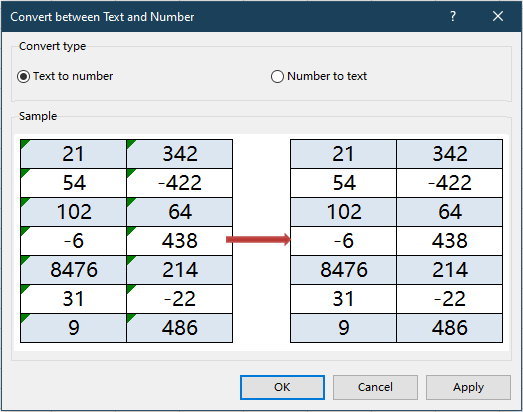¿Cómo hacer una búsqueda vertical (VLOOKUP) de números almacenados como texto en Excel?
Al usar VLOOKUP en Excel, encontrarse con formatos incompatibles —específicamente, cuando un valor de búsqueda está almacenado como texto mientras que la columna de búsqueda contiene números, o viceversa— puede provocar fallos o errores en la búsqueda. Esta incompatibilidad de formato es un problema común, especialmente cuando los datos provienen de fuentes externas, se importan o al trabajar con grandes conjuntos de datos colaborativos. Resolver estas incompatibilidades es esencial para asegurar que VLOOKUP funcione como se espera y te permita recuperar la información correcta. Esta guía paso a paso introduce varias soluciones prácticas para abordar estas inconsistencias de formato, garantizando búsquedas confiables y precisas sin importar cómo se almacenen los números en tu libro.
Este artículo demostrará formas efectivas de manejar tales errores, incluyendo ajustes de fórmulas, herramientas integradas de Excel y automatización mediante VBA para procesamiento masivo o automatizado. También discutimos los beneficios y consideraciones de cada método, ayudándote a elegir el enfoque más adecuado para tu escenario.
- Buscar números almacenados como texto con fórmulas
- Corrige rápidamente incompatibilidades de formato con Kutools para Excel
- Macro VBA: Estandarizar formatos antes de VLOOKUP
- Otros métodos integrados de Excel: Usa 'Texto en columnas' para corregir formatos de datos

Buscar números almacenados como texto con fórmulas
Si tus datos de búsqueda incluyen números almacenados como texto en un lugar y números reales en otro, VLOOKUP puede fallar al encontrar coincidencias debido a esta inconsistencia de formato. Una de las soluciones más directas es usar fórmulas de Excel que conviertan el valor de búsqueda o la columna de búsqueda a un formato consistente sobre la marcha. Este enfoque funciona bien en la mayoría de las operaciones de hoja de cálculo, es fácil de aplicar y mantiene tus datos originales sin cambios.
Por ejemplo, si tu valor de búsqueda está almacenado como texto, mientras que el campo correspondiente en la tabla está formateado como número, puedes usar la función VALUE para convertir el texto a un número dentro de la fórmula VLOOKUP.
Introduce la siguiente fórmula en una celda en blanco donde deseas mostrar el resultado:
=VLOOKUP(VALUE(G1),A2:D15,2,FALSE)Después de introducir la fórmula, presiona la tecla Enter para recuperar el valor correspondiente a tus criterios, como se ilustra en la captura de pantalla a continuación:

Explicación de parámetros y consejos:
- G1: La celda que contiene el valor que deseas buscar (puede ser texto o número).
- A2:D15: El rango de tu tabla de datos que incluye la columna de búsqueda y las columnas que contienen la información que deseas devolver.
- 2: El número de columna (desde la columna más a la izquierda del rango de la tabla) para el resultado que deseas devolver.
Ten en cuenta eliminar espacios iniciales/finales en los valores de búsqueda, ya que estos también pueden provocar fallos en la búsqueda. Considera combinar la función TRIM si tus datos pueden contener espacios adicionales.
Si el valor de búsqueda es un número real (formato numérico), pero el campo correspondiente en la tabla está almacenado como texto, necesitarás convertir el número a texto antes de realizar la búsqueda. La función TEXT es adecuada para este escenario:
=VLOOKUP(TEXT(G1,0),A2:D15,2,FALSE)Introduce esto en tu celda objetivo, presiona Enter y se devolverá el resultado correcto, como se muestra a continuación:

Aquí, el código de formato numérico “0” dentro de la función TEXT asegura que tu número sea convertido a un valor de texto plano antes de la coincidencia.
Si no estás seguro de los posibles formatos de tus valores de búsqueda o esperas que tanto texto como números aparezcan en tu columna de búsqueda, puedes anidar ambos enfoques usando la función IFERROR para manejar todas las posibilidades sin problemas:
=IFERROR(VLOOKUP(VALUE(G1),A2:D15,2,0),VLOOKUP(TEXT(G1,0),A2:D15,2,0))Introduce esta fórmula en tu celda de resultados. Primero intentará la búsqueda convirtiendo tu valor a un número; si eso falla (por ejemplo, si el valor no puede forzarse a un número), intentará convertir tu valor a texto y lo buscará nuevamente. Esto es especialmente útil en conjuntos de datos con formatos mixtos o en archivos compartidos donde los estándares de entrada de datos no son uniformes.
Después de introducir cualquiera de las fórmulas anteriores, recuerda copiar la fórmula hacia abajo en celdas adyacentes si necesitas aplicarla a múltiples valores de búsqueda —simplemente selecciona la celda, arrastra el controlador de relleno hacia abajo, o usa Ctrl+C y Ctrl+V según sea necesario. Para tablas grandes, usar estas fórmulas ayuda a asegurar coincidencias confiables sin alterar tu base de datos original.
Este método proporciona una solución flexible y universalmente aplicable para la mayoría de las búsquedas basadas en hojas de cálculo. Sin embargo, para conjuntos de datos muy grandes o cuando necesitas procesar muchos registros automáticamente, podrías considerar usar herramientas de automatización como VBA para una mayor eficiencia.
Corrige rápidamente incompatibilidades de formato con Kutools para Excel
Si prefieres una solución más rápida y sin fórmulas, Kutools para Excel ofrece una herramienta fácil de usar llamada Convertir entre Texto y Número. Esta característica te permite convertir números almacenados como texto en números reales —o viceversa— con solo unos pocos clics. Es especialmente útil para resolver problemas de formato antes de realizar búsquedas como VLOOKUP o MATCH.
Después de instalar Kutools para Excel, sigue los siguientes pasos.
- Selecciona el rango que contiene tus datos problemáticos (por ejemplo, números almacenados como texto).
- Ve a "Kutools" > "Texto" > "Convertir entre Texto y Número".
- En el cuadro de diálogo emergente:
- Elige "Texto a número" si estás arreglando fallos de búsqueda debido a números formateados como texto. (O selecciona "Número a texto" si los valores de búsqueda están almacenados como texto.)
- Haz clic en "Aceptar" para convertir inmediatamente el formato de los datos.

- Elige "Texto a número" si estás arreglando fallos de búsqueda debido a números formateados como texto.
Después de convertir texto a números, las celdas convertidas se comportarán como números verdaderos y ya no mostrarán indicadores de triángulo verde por inconsistencias.
Este enfoque elimina la necesidad de columnas auxiliares, fórmulas o VBA —haciéndolo ideal para una limpieza rápida antes de aplicar VLOOKUP.
Kutools para Excel - Potencia Excel con más de 300 herramientas esenciales. ¡Disfruta de funciones de IA gratis permanentemente! Consíguelo ahora
Macro VBA: Estandarizar formatos antes de VLOOKUP
Para usuarios que trabajan regularmente con grandes conjuntos de datos, reciben archivos de fuentes externas o requieren automatización repetida, usar una macro simple de VBA puede estandarizar programáticamente el formato de los datos tanto en la columna del valor de búsqueda como en la columna de la tabla de búsqueda. De esta manera, aseguras que todos los datos se conviertan a texto o número antes de ejecutar VLOOKUP, eliminando errores de coincidencia debidos a incompatibilidades de formato. VBA es especialmente útil para el procesamiento masivo, ahorrando ajustes manuales y garantizando la consistencia de los datos mediante la automatización.
Ventajas: Automatización del formato para rangos de datos grandes o flujos de trabajo frecuentes; minimiza el riesgo de formato perdido o inconsistente; adecuado para tareas repetitivas.
Desventajas: No es adecuado para usuarios con restricciones de macros o aquellos no familiarizados con el uso de macros VBA.
Aquí te mostramos cómo usar una macro para estandarizar los formatos de celda:
1. Ve a la pestaña Desarrollador y haz clic en Visual Basic para abrir el editor de VBA. En la nueva ventana, haz clic en Insertar > Módulo, luego copia y pega el siguiente código en el área del módulo:
Sub StandardizeLookupFormats()
' Ask the user to select the lookup column and choose a target format
Dim rng As Range
Dim userChoice As Integer
Dim xTitleId As String
On Error Resume Next
xTitleId = "KutoolsforExcel"
Set rng = Application.InputBox("Select the range to standardize (lookup or data column):", xTitleId, Type:=8)
If rng Is Nothing Then Exit Sub
userChoice = MsgBox("Convert selected data to Number? (Click Yes to convert to Number, No to convert to Text)", vbYesNoCancel, xTitleId)
If userChoice = vbYes Then
For Each cell In rng
If IsNumeric(cell.Value) Then
cell.Value = Val(cell.Value)
cell.NumberFormat = "General"
End If
Next
ElseIf userChoice = vbNo Then
For Each cell In rng
If Not IsEmpty(cell.Value) Then
cell.Value = CStr(cell.Value)
cell.NumberFormat = "@"
End If
Next
Else
Exit Sub
End If
End Sub2. Cierra el editor de VBA. Para ejecutar la macro, regresa a Excel, presiona Alt+F8, selecciona StandardizeLookupFormats y haz clic en Ejecutar.
Detalles de operación y consejos:
- Esta macro te pedirá que selecciones la columna (ya sea tu rango de BÚSQUEDA o rango de TABLA) que deseas estandarizar.
- Después de la selección, te preguntará si deseas convertir el rango a números (haz clic en Sí) o a texto (haz clic en No). Selecciona el mismo formato para tus columnas de búsqueda y tabla para asegurar que VLOOKUP coincida de manera confiable.
- Después de ejecutar esta macro, es posible que necesites recalcular la hoja de cálculo (presiona F9) o volver a aplicar tus fórmulas VLOOKUP si los resultados no aparecen inmediatamente.
- Si recibes un error indicando que las macros están deshabilitadas, habilita las macros en la configuración de Excel antes de proceder.
Esta solución es ideal para importaciones de datos recurrentes o cuando se limpian columnas inconsistentes en grandes conjuntos de datos antes de aplicar VLOOKUP u otras operaciones de búsqueda.
Otros métodos integrados de Excel: Usa 'Texto en columnas' para corregir formatos de datos
Una forma rápida de alinear formatos de número y texto en Excel es usar la función Texto en columnas. Esta herramienta integrada se usa a menudo para dividir datos, pero también puede forzar una conversión de formato sin editar fórmulas, lo que la hace útil cuando quieres una corrección única o al tratar con listas sencillas.
Pros: Muy fácil, no se necesitan fórmulas o código, conserva la estructura de datos original; Contras: Mejor para correcciones únicas, no se actualiza automáticamente si los datos cambian.
Para usar este método para convertir números almacenados como texto (o viceversa) en una columna:
- Selecciona la columna con el formato sospechado de incompatibilidad (por ejemplo, tu columna de búsqueda o la columna referenciada por VLOOKUP).
- En la pestaña Datos, haz clic en Texto en columnas.
- En el asistente, elige Delimitado, luego haz clic en Siguiente.
- Deselecciona todas las casillas de verificación de delimitadores (ya que no estás dividiendo los datos); haz clic en Siguiente.
- En Formato de datos de columna, selecciona General (para forzar a Excel a reconocer números como números) o selecciona Texto (para convertir números a texto).
- Haz clic en Finalizar para completar el proceso.
Una vez hecho, tus datos tendrán su formato alineado forzosamente a número o texto, resolviendo las incompatibilidades de VLOOKUP. Siempre verifica algunas celdas para confirmar que la conversión funcionó como se esperaba. Si es necesario, repite el proceso tanto para tu columna de búsqueda como para tus valores de búsqueda para maximizar la consistencia.
Recordatorios prácticos: “Texto en columnas” modifica los datos directamente, por lo que puede sobrescribir el contenido de las celdas si tienes datos existentes inmediatamente a la derecha. Considera copiar tu columna a un área en blanco primero si no estás seguro, y siempre guarda una copia de seguridad de tu archivo antes de usar herramientas de datos masivos.
Las mejores herramientas de productividad para Office
Mejora tu dominio de Excel con Kutools para Excel y experimenta una eficiencia sin precedentes. Kutools para Excel ofrece más de300 funciones avanzadas para aumentar la productividad y ahorrar tiempo. Haz clic aquí para obtener la función que más necesitas...
Office Tab incorpora la interfaz de pestañas en Office y facilita mucho tu trabajo
- Habilita la edición y lectura con pestañas en Word, Excel, PowerPoint, Publisher, Access, Visio y Project.
- Abre y crea varios documentos en nuevas pestañas de la misma ventana, en lugar de hacerlo en ventanas separadas.
- ¡Aumenta tu productividad en un50% y reduce cientos de clics de ratón cada día!
Todos los complementos de Kutools. Un solo instalador
El paquete Kutools for Office agrupa complementos para Excel, Word, Outlook y PowerPoint junto con Office Tab Pro, ideal para equipos que trabajan en varias aplicaciones de Office.
- Suite todo en uno: complementos para Excel, Word, Outlook y PowerPoint + Office Tab Pro
- Un solo instalador, una licencia: configuración en minutos (compatible con MSI)
- Mejor juntos: productividad optimizada en todas las aplicaciones de Office
- Prueba completa de30 días: sin registro ni tarjeta de crédito
- La mejor relación calidad-precio: ahorra en comparación con la compra individual de complementos
